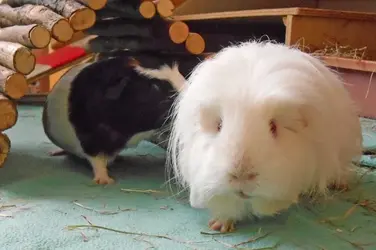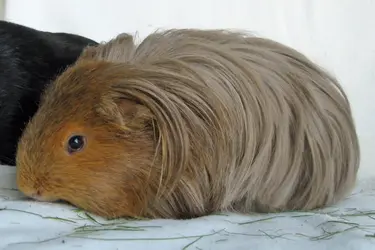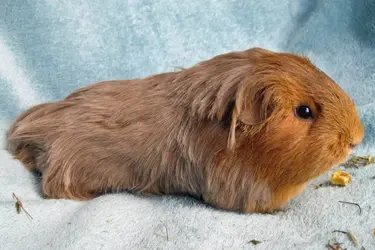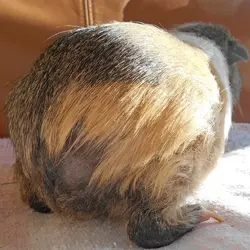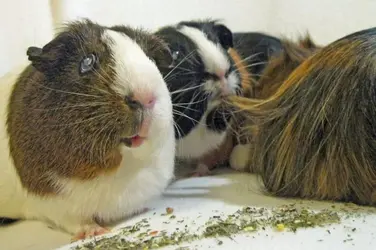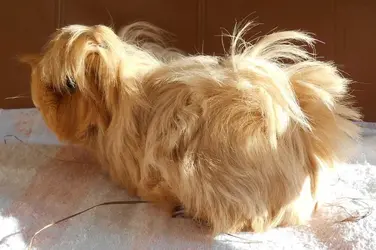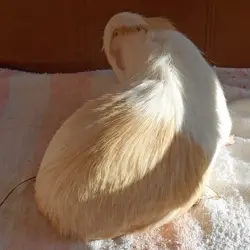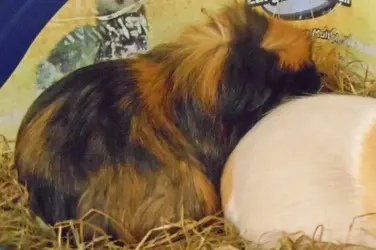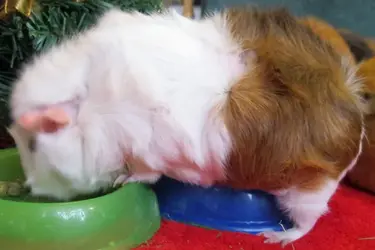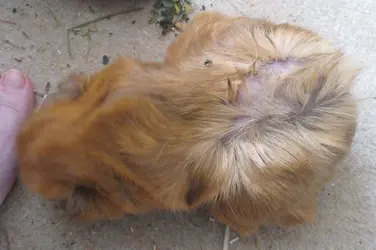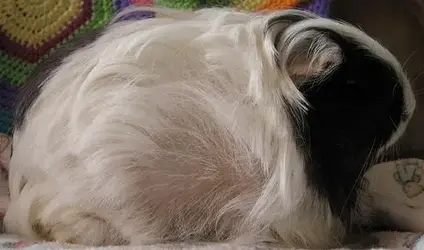1 What is barbering?
2 Barbering other guinea pigs
- Social grooming
- Dominance grooming
3 Self-barbering
- Habitual over-grooming
- Stress
- Pain
4 Problems that can look similar to barbering
- Skin parasites and ringworm
- Hormonal problems and nutritional deficiencies
- Normal bald patches
5 Conclusion
We are still guessing as to what prompts guinea pigs to eat their own or their companions’ hair. What is however obvious is that barbering is a much more complex issue than you tend to find in the rather scarce good quality online sources. The causes for barbering can vary widely in my own experience. In this little guide, I am going to show up some of the contexts in which barbering can happen, using my own guinea pigs as examples.
1 What is barbering?
Under barbering we understand the eating of hairs, either from other guinea pigs or their own. Barbering can also extend to human hair. It is not a rare behaviour, but it is generally more frequent and noticeable in long-haired guinea pigs.
This short video here shows Ffraid barbering Hafren and the typical reaction from a protesting companion:
Is barbering harmful?
Guinea pigs don’t develop hair balls in their intestines, so it is not a dangerous habit.
Will the hair grow back?
Yes, barbered hairs grow back immediately and quickly to normal short-hair length within around a month in short-haired guinea pigs. Long-haired guinea pigs take obviously somewhat longer.
What can I do to prevent barbering?
Unless you need to separate in severe cases where the hair is eaten right down to leave wide swathes of bare skin, there is not a lot you can and should do. I do not recommend spraying guinea pigs with whatever substances you find touted around on social media, many of which contain unsuitable components.
The companions will usually tolerate it, complain, move away or swipe at the barberer depending on whether and how unpleasant the barbering is and in which context it happens.
However, not all barbering is simply random or just naughty behaviour, so it is vital that you always look at the situation and context in which a guinea pig is barbering. In the following I am going to look at a range of scenarios, which I am illustrating with experiences with my own guinea pigs.
2 Barbering other guinea pigs
- Social grooming
- Dominance grooming
3 Self-barbering
- Habitual over-grooming
- Stress
- Pain
4 Problems that can look similar to barbering
- Skin parasites and ringworm
- Hormonal problems and nutritional deficiencies
- Normal bald patches
5 Conclusion
We are still guessing as to what prompts guinea pigs to eat their own or their companions’ hair. What is however obvious is that barbering is a much more complex issue than you tend to find in the rather scarce good quality online sources. The causes for barbering can vary widely in my own experience. In this little guide, I am going to show up some of the contexts in which barbering can happen, using my own guinea pigs as examples.
1 What is barbering?
Under barbering we understand the eating of hairs, either from other guinea pigs or their own. Barbering can also extend to human hair. It is not a rare behaviour, but it is generally more frequent and noticeable in long-haired guinea pigs.
This short video here shows Ffraid barbering Hafren and the typical reaction from a protesting companion:
Is barbering harmful?
Guinea pigs don’t develop hair balls in their intestines, so it is not a dangerous habit.
Will the hair grow back?
Yes, barbered hairs grow back immediately and quickly to normal short-hair length within around a month in short-haired guinea pigs. Long-haired guinea pigs take obviously somewhat longer.
What can I do to prevent barbering?
Unless you need to separate in severe cases where the hair is eaten right down to leave wide swathes of bare skin, there is not a lot you can and should do. I do not recommend spraying guinea pigs with whatever substances you find touted around on social media, many of which contain unsuitable components.
The companions will usually tolerate it, complain, move away or swipe at the barberer depending on whether and how unpleasant the barbering is and in which context it happens.
However, not all barbering is simply random or just naughty behaviour, so it is vital that you always look at the situation and context in which a guinea pig is barbering. In the following I am going to look at a range of scenarios, which I am illustrating with experiences with my own guinea pigs.
